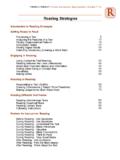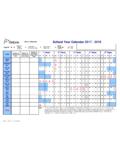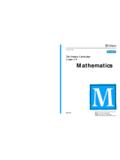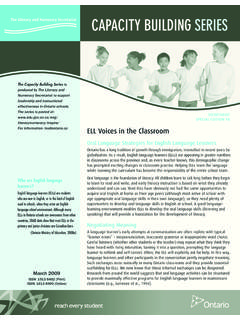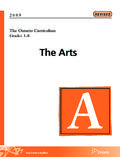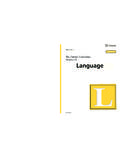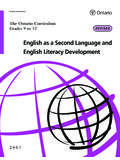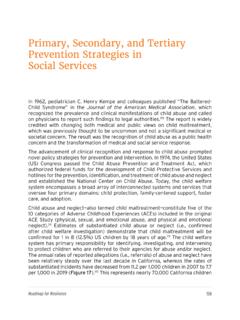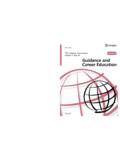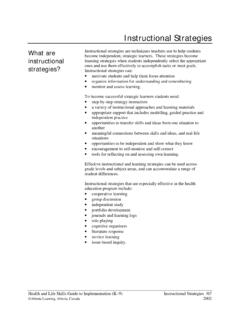Transcription of Health and Physical Education - Ministry of Education
1 Health and Physical Education REVISEDThe Ontario Curriculum Grades 9 to 122015 The Ontario Public Service endeavours to demonstrate leadership with respect to accessibility in Ontario. Our goal is to ensure that Ontario government services, products, and facilities are accessible to all our employees and to all members of the public we serve. This document, or the information that it contains, is available, on request, in alternative formats. Please forward all requests for alternative formats to ServiceOntario at 1-800-668-9938 (TTY: 1-800-268-7095).CONTENTSPREFACE 3 secondary Schools for the Twenty-First Century .. 3 Supporting Students Well-being and Ability to Learn .. 3 INTRODUCTION 6 Vision and Goals of the Health and Physical Education Curriculum.
2 6 The Importance of the Health and Physical Education Curriculum .. 7 Fundamental Principles in Health and Physical Education .. 9 Foundations for a Healthy School .. 10 Roles and Responsibilities in Health and Physical Education .. 12 THE PROGRAM IN Health AND Physical Education 19 Overview .. 19 Curriculum Expectations .. 23 The Strands and the Living Skills Expectations in the Healthy Active Living Education Courses .. 25 The Strands in the Grade 11 and 12 Destination Courses, and the Treatment of Living Skills .. 43 ASSESSMENT AND EVALUATION OF STUDENT ACHIEVEMENT 45 Basic Considerations .. 45 The Achievement Chart for Health and Physical Education , Grades 9 12 .. 48 SOME CONSIDERATIONS FOR PROGRAM PLANNING IN Health AND Physical Education 54 Instructional Approaches and Teaching Strategies .. 54 Health and Safety in Health and Physical Education .. 61 Planning Health and Physical Education Programs for Students with Special Education Needs.
3 63 Program Considerations for English Language Learners .. 67 Environmental Education and Health and Physical Education .. 69 Healthy Relationships and Health and Physical Education .. 70 Equity and Inclusive Education in Health and Physical Education .. 72 Une publication quivalente est disponible en fran ais sous le titre suivant : Le curriculum de l Ontario, 9e 12e ann e ducation physique et sant , 2015 This publication is available on the Ministry of Education s website, at Literacy in Health and Physical Education .. 74 Literacy, Inquiry Skills, and Numeracy in Health and Physical Education .. 75 The Role of the School Library in Health and Physical Education .. 79 The Role of Information and Communications Technology in Health and Physical Education .. 80 The Ontario Skills Passport: Making Learning Relevant and Building Essential Skills and Work Habits .. 81 Education and Career/Life Planning Through the Health and Physical Education Curriculum.
4 82 Cooperative Education and Other Forms of Experiential Learning .. 83 Planning Program Pathways and Programs Leading to a Specialist High Skills Major .. 84 Ethics in the Health and Physical Education Program .. 84 COURSES 87 Healthy Active Living Education , Grade 9, Open (PPL1O) .. 89 Healthy Active Living Education , Grade 10, Open (PPL2O) .. 109 Healthy Active Living Education , Grade 11, Open (PPL3O) .. 127 Healthy Active Living Education , Grade 12, Open (PPL4O) .. 145 Health for Life, Grade 11, College Preparation (PPZ3C) .. 161 Introductory Kinesiology, Grade 12, University Preparation (PSK4U) .. 175 Recreation and Healthy Active Living Leadership, Grade 12, University/College Preparation (PLF4M) .. 187 APPENDIX: Learning Summaries by Strand 201 GLOSSARY 2072 PREFACEThis document replaces The Ontario Curriculum, Grades 9 and 10: Health and Physical Education , 1999 and The Ontario Curriculum, Grades 11 and 12: Health and Physical Education , 2000.
5 Beginning in September 2015, all Health and Physical Education courses for Grades 9 to 12 will be based on the expectations outlined in this document. secondary SCHOOLS FOR THE TWENTY-FIRST CENTURYThe goal of Ontario secondary schools is to support high-quality learning while giving individual students the opportunity to choose programs that suit their skills and interests. The updated Ontario curriculum, in combination with a broader range of learning options outside traditional classroom instruction, will enable students to better customize their high school Education and improve their prospects for success in school and in revised curriculum recognizes that, today and in the future, students need to be critically literate in order to synthesize information, make informed decisions, communicate effectively, and thrive in an ever-changing global community. It is important that students be connected to the curriculum; that they see themselves in what is taught, how it is taught, and how it applies to the world at large.
6 The curriculum recognizes that the needs of learners are diverse, and helps all learners develop the knowledge, skills, and perspectives they need to be informed, productive, caring, responsible, healthy, and active citizens in their own communities and in the STUDENTS WELL-BEING AND ABILITY TO LEARNP romoting the healthy development of all students, as well as enabling all students to reach their full potential, is a priority for educators across Ontario. Students Health and well-being contribute to their ability to learn in all disciplines, including Health and Physical Education , and that learning in turn contributes to their overall well-being. The Health and Physical Education curriculum engages students in learning about the factors that contribute to Health and well-being and in building skills to live healthy, active play an important role in promoting children and youth s well-being by creating, fostering, and sustaining a learning environment that is healthy, caring, safe, inclusive, and accepting.
7 A learning environment of this kind will support not only students cognitive, emotional, social, and Physical development but also their mental Health , their resilience, and their overall state of well-being. All this will help them achieve their full potential in school and in ONTARIO CURRICULUM, GRADES 9 12 | Health and Physical EducationA variety of factors, known as the determinants of Health (discussed in this document on pages 11 12), have been shown to affect a person s overall state of well-being. Some of these are income, Education and literacy, gender and culture, Physical and social environment, personal Health practices and coping skills, and availability of Health services. Together, such factors influence not only whether a person is physically healthy but also the extent to which he or she will have the Physical , social, and personal resources needed to cope and to identify and achieve personal aspirations. These factors also have an impact on student learning, and it is important to be aware of them as factors contributing to a student s educator s awareness of and responsiveness to students cognitive, emotional, social, and Physical development is critical to their success in school.
8 A number of research-based frameworks, including those described in Early Learning for Every Child Today: A Framework for Ontario Early Childhood Settings (2007) and Stepping Stones: A Resource on Youth Development (2012),1 identify developmental stages that are common to the majority of students from Kindergarten to Grade 12. At the same time, these frameworks recognize that individual differences, as well as differences in life experiences and exposure to opportunities, can affect development, and that developmental events are not specifically age-dependent. The framework described in Stepping Stones is based on a model that illustrates the complexity of human development. Its components the cognitive, emotional, Physical , and social domains are interrelated and interdependent, and all are subject to the influence of a person s environment or context. At the centre is an enduring (yet changing) core a sense of self, or spirit that connects the different aspects of development and experience (p.)
9 17). Source: Stepping Stones: A Resource on Youth Development, p. 171. Best Start Expert Panel on Early Learning, Early Learning for Every Child Today: A Framework for Ontario Early Childhood Settings (2007) is available at , and Government of Ontario, Stepping Stones: A Resource on Youth Development (2012), is available at who have an awareness of a student s development take each component into account, with an understanding of and focus on the following elements: cognitive development brain development, processing and reasoning skills, use of strategies for learning emotional development emotional regulation, empathy, motivation social development self-development (self-concept, self-efficacy, self-esteem); identity formation (gender identity, social group identity, spiritual identity); relationships (peer, family, romantic) Physical development Physical activity, sleep patterns, changes that come with puberty, body image, nutritional requirementsThe Role of Mental Health Mental Health touches all components of development.
10 As students will learn in the courses outlined in this document, mental Health is much more than the absence of mental illness. Well-being is influenced not only by the absence of problems and risks but by the presence of factors that contribute to healthy growth and development. By nurturing and supporting students strengths and assets, educators help promote positive mental Health in the classroom. At the same time, they can identify students who need additional support and connect them with the appropriate happens at school can have a significant influence on a student s well-being. With a broader awareness of mental Health , educators can plan instructional strategies that contribute to a supportive classroom climate for learning in all subject areas, build awareness of mental Health , and reduce stigma associated with mental illness. Taking students well-being, including their mental Health , into account when planning instructional approaches helps establish a strong foundation for See the Ministry document Supporting Minds: An Educator s Guide to Promoting Students Mental Health and Well-being (2013), and pages 39 40 and 42 43 in this document.
